Skeleton Bay: The Death of a Wave Foretold
 Skeleton Bay, the world's most perfect and thought provoking sand-bottom left hand point break may not exist in twenty years time. It's a bold statement to make so let's qualify it: Skeleton Bay as the surfing world knows it – that is, a kilometres-long, thick-lipped, freight-train barrel – may not exist in twenty years. Although if coastal processes continue as they have there is a very real chance the bay may not exist at all.
Skeleton Bay, the world's most perfect and thought provoking sand-bottom left hand point break may not exist in twenty years time. It's a bold statement to make so let's qualify it: Skeleton Bay as the surfing world knows it – that is, a kilometres-long, thick-lipped, freight-train barrel – may not exist in twenty years. Although if coastal processes continue as they have there is a very real chance the bay may not exist at all.
As a wave, Skeleton Bay was only brought to the surfing world's attention very recently. Four years ago, American surfer Brian Gable submitted Skeleton Bay as an entry to Surfing Magazine's 'Google Earth Challenge 2' competition, which he subsequently won.
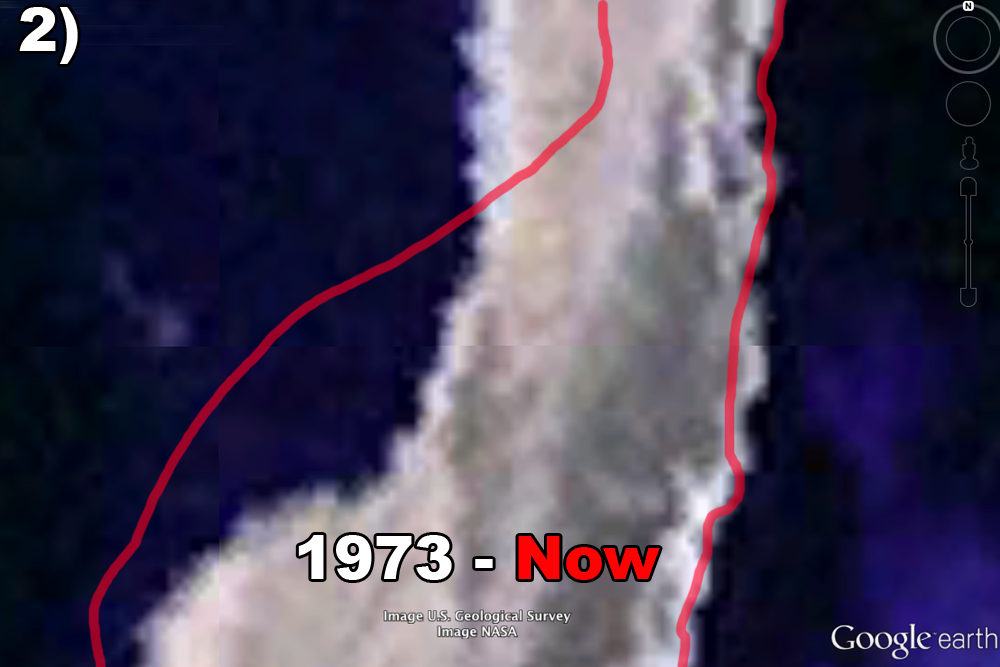
Shortly thereafter Cory Lopez was filmed in a ridiculously long barrel which led to the wave being known as 'Cory's Left' for a short while. Since then it's been documented by an increasing number of surfers to the point where each swell sees the beach lined with 4WDs and cameramen who've travelled from South Africa or even further afar.
It appears there's a conspicuous absence of locals at Skeleton Bay, especially long time locals, which seems unusual for a wave of such quality near a medium sized township. Yet if we look at historical maps of the region it becomes clear why that is. Just fifteen years prior to Brian's online discovery, the perfect shape of the sandspit that features in so many magazines and videos was considerably different to its current state.
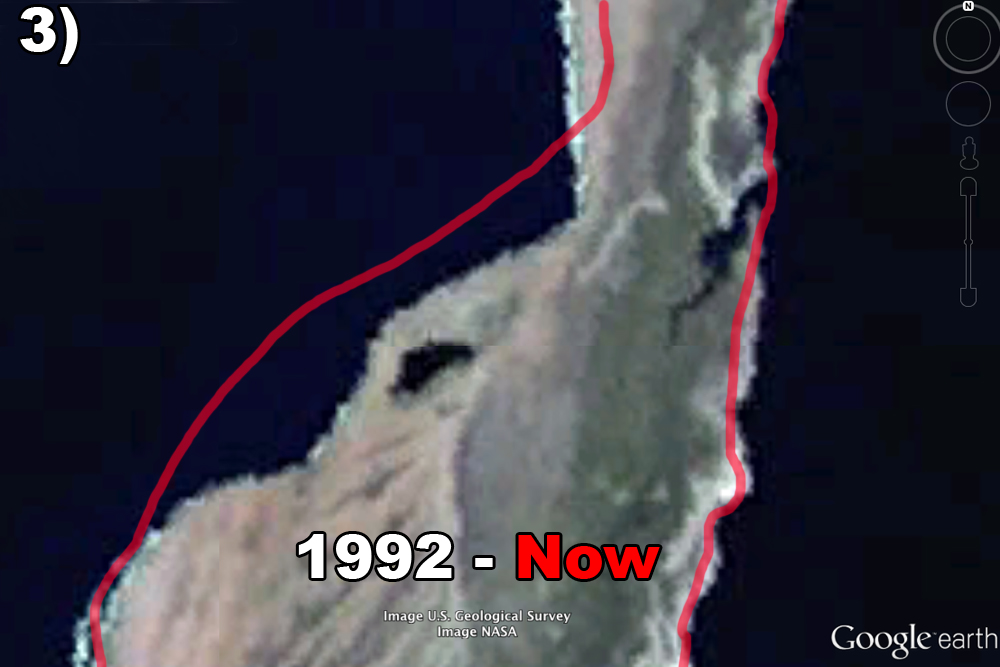
The location of this incredible wave is right on the edge of one of the oldest deserts in the world. This region of Africa is also unique in that the combination of strong southerly winds over the desert and northward flowing coastal currents are causing a reclamation of land; Skeleton Bay is growing north-westward into the South Atlantic Ocean at a rate of approximately ten metres every year.

Testament to this incredible rate of land reclamation is the wreck of 'Eduard Bohlen' (images 7 & 8) not far from Skeleton Bay. In 1909 the ill-fated cargo ship ran aground in thick fog on the Skeleton Coast. Now, over one hundred years later, the shipwreck lies four hundred metres inland from the Atlantic Ocean and some eight hundred metres from where waves currently break. The Eduard Bohlen marks the old coastline yet it now sits completely surrounded by sand in a dramatic reminder of how dynamic the coastline here is.
The shape of Skeleton Bay has changed considerably over the past forty years due to large amounts of sand moving northward along the sand spit. At the moment the wave is approximately one kilometre further north of where it would have broken in 1973 (image 2), and almost four hundred metres north of where it was positioned in 1992 (image 3).
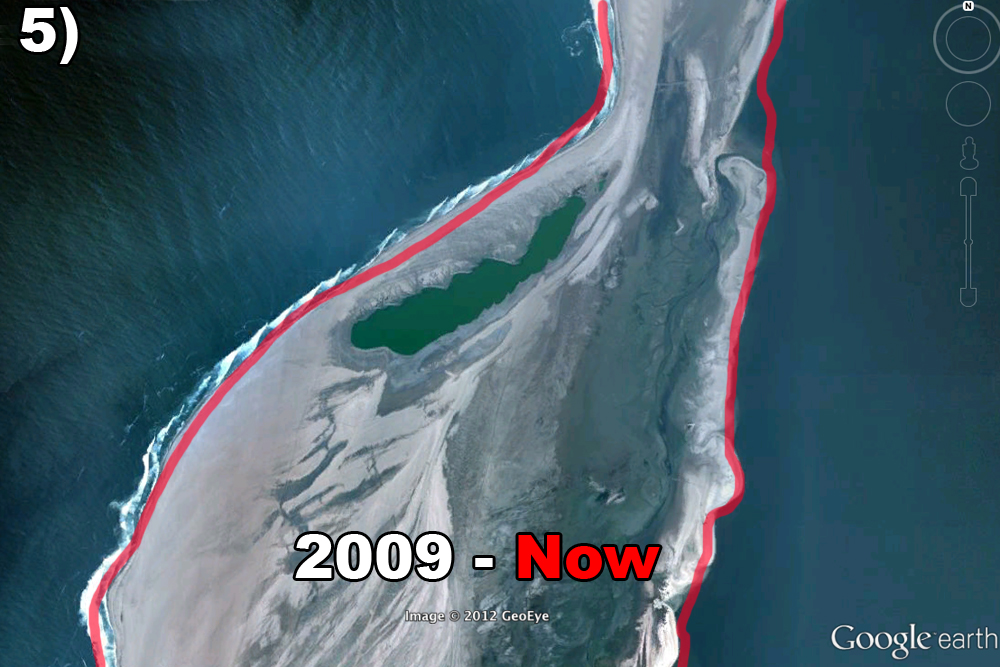 More recently the adjacent lagoon breached its banks in 2000 (image 4), washing away the entire second half of the sand spit. This is likely to have caused a fundamental change to the characteristics of the surf, if not completely wiping out the last kilometre of the wave that we currently know.
More recently the adjacent lagoon breached its banks in 2000 (image 4), washing away the entire second half of the sand spit. This is likely to have caused a fundamental change to the characteristics of the surf, if not completely wiping out the last kilometre of the wave that we currently know.
While Skeleton Bay has moved slowly north over the past few decades, its angle has also changed to a slightly 'straighter' west-east orientation. This current alignment seems to be the perfect angle to bend incoming swells into mechanical and makeable two-kilometre-long barrels.
 Due to the constantly changing geomorphology around Skeleton Bay, numerous studies have been conducted on the sandspit it lies along due to the protection it provides to a harbour and town directly east. While providing surfers with a flawless wave it also acts as a buffer to persistent swells and winds moving up from the south.
Due to the constantly changing geomorphology around Skeleton Bay, numerous studies have been conducted on the sandspit it lies along due to the protection it provides to a harbour and town directly east. While providing surfers with a flawless wave it also acts as a buffer to persistent swells and winds moving up from the south.
One study estimates that nearly 1 million cubic metres of sand flows past Skeleton Bay per year, with the spit just north of the wave surveyed to grow 340 metres between 1980 and 1996. That's a remarkable 22.6 metres a year, but while this sand nourishing is occurring north of Skeleton Bay, at the end of the actual wave proper, erosion is occurring at an alarming rate with the peninsula narrowing towards the harbour. If this continues the ocean could once again breach the sandspit, not only affecting the wave quality but making the harbour more vulnerable to Atlantic swell activity.
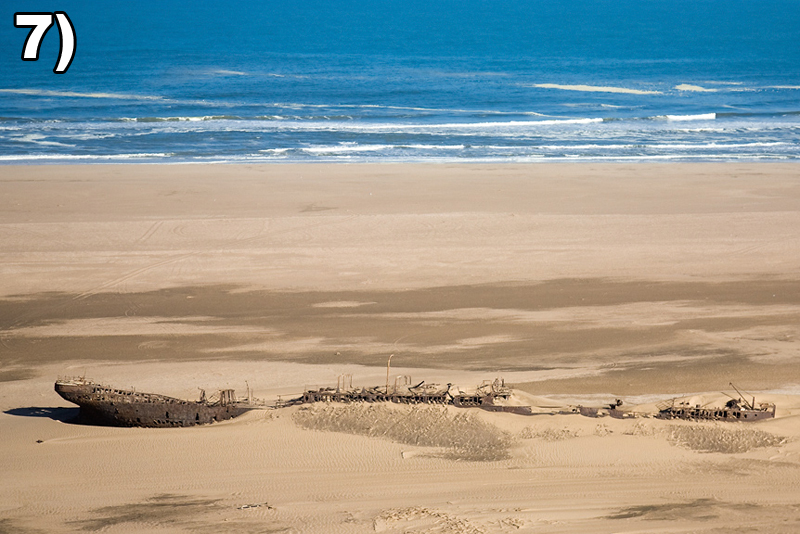 This is a very real scenario if the region receives back to back storm swells, and with the sandspit lying only one metre above mean sea level there's even been talk of preventative measures to stop the breaching. One temporary measure details bulldozing sand south of the wave so that it flows north and slows down the erosion. Other measures include sandbagging the narrow area, there's even talk of a groyne being built at the end of the wave to help in sand accretion.
This is a very real scenario if the region receives back to back storm swells, and with the sandspit lying only one metre above mean sea level there's even been talk of preventative measures to stop the breaching. One temporary measure details bulldozing sand south of the wave so that it flows north and slows down the erosion. Other measures include sandbagging the narrow area, there's even talk of a groyne being built at the end of the wave to help in sand accretion.
With all this natural change one can easily come to the conclusion that surfers have stumbled across this wave in its prime, and it may not be long before the wave itself disappears as quickly as it was formed.
But the big questions is this: how long can we expect Skeleton Bay to hold its current shape after so much change in the last forty years? After all it's a sand-bottom wave and the contours that make it so special are perpetually changing.
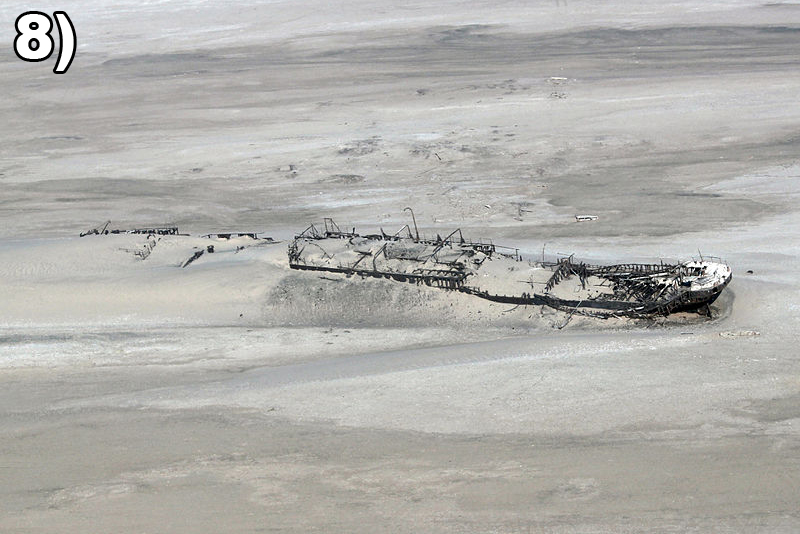
While it's hard to say how long Skeleton Bay will remain a world class break what we can learn is that many of our coastlines are constantly evolving and this leads to a very exciting thought: the search for the perfect wave may literally be endless. While it sounds like marketing fantasy the fact is our coastlines are constantly evolving, some of them rapidly. As they do, the potential for new and untapped discoveries like Skeleton Bay remains everpresent.
By CRAIG BROKENSHA with STU NETTLE.
Video of Cory Lopez's first wave at Skeleton Bay: Lost.TV - Cory's Left Image 7 coutresy of http://heinrichs-family.de


Comments
nice read lads...twiggy been surfing this joint for a long time...he has some crazy storys about it coming and going.....theres some sand building at a location close to home as we speak!!
You might wanna pass the story on to Twig then.
hey easy stuey...u sound a lil sarastic this fine mornin?? do you have some Post natal depession or sumthn? forgive me if i'm wrong tho.
i genuinely meant good read bruz...twig will be impressed with it also i'm sure....he was surfing it in the beginning when it first formed the lucky bugga.
No sarcasm intended. I'd like people beyond Australia and our usual viewers to read it.
The world is full of narural footers but the best waves are all lefts, why is that?
I'll give it a go...
The majority of the oceans are in the southern hemisphere with the southern storm track/Roaring 40s circling the globe. Swells borne in the Roaring 40s travel north up the South Atlantic, Indian and South Pacific Oceans toward land masses. Where they meet is often in the south-east tradewind belt where winds blow offshore on the south or west sides of these coasts. Think Skeleton Bay, St Leu, G'land, the whole Bukit Peninsula, Tombstones, Red Bluff and Teahupoo.
Thats a mighty fine list of waves ya got there stu! Add deserts, supersuck and a few more little treats and its perfect!
Yeah, except I'm a natural footer!
stunet...u are one fine scholar!!! to think i have been searchn the northern hemi all these years to no avail....thanx bra, you have saved my life!!!
goofy is gd yah?
Fantastic story Craig. Is it an Autralian mentality that the coastline is static and unchanging? Talk with John McGroder or other long time Mentawaii surfers and hear how the Ments coastline is in constant flux, the surfing bathymetries, coral reefs, raise and sink on a regular basis, with dramatic changes from one season to the next.
Stu, i counted 225 reefbreaks on the east coast of Australia, 70% are righthanders... any theories?
" i counted 225 reefbreaks on the east coast of Australia, 70% are righthanders... any theories?"
No, but gimme a day or two and I can make one up!
Funny you should mention the Mentawai and Bucket McGroder, Andy. Keep an eye out for a story on the Sunda megathrust and the effects it's having on the Ments. Includes a few observations from McGroder.
You forgot about one of the best on the eastcoast, box head, over a k of fine sand offerings, and shhhhmucks, fark you dribble some shit, you sound just like big wanker, thinks yous r the same
why grom??? box head...hmmmm i heard about that joint b4 u i rekn gromful...thinkss u same???
hmmmm
shmuck, you heard about it before me hey, how do you work that out, aren't you a born n bred west coast south Australian,i didn't hear about it, i first surfed it over thirty years ago,
"i counted 225 reefbreaks on the east coast of Australia, 70% are righthanders... any theories?"
Simple really: dominant swell direction in relation to the general coastal orientation. Dominant swell direction is south west in West Oz, SA and Vic and south east in NSW and Qld. The only coast with an orientation which favors lefts is WA.
Cheers Andrew, and as crabs has pointed out above, it's all about the dominant swell direction relative to the alignment of the coast.
Lots of rights on east facing coasts and lots of lefts on west facing coasts as a general rule.
..........and lots of closeouts along the south facing coast?
Lots of slabs on south facing coasts from my experience....
this a great story, i know our own east coast has a lot of sand movement, but not as much as this coastline, but there a number of areas that without man's intervention would be somewhat different to now, the Sydney region, the mid and north coasts, and obviously the tweed/queensland border. it would be interesting to see how they would have ended up without us, better or worse will never know
Great read Craig! I have photos from '70's - '90's of Witches Rock in CR. The estuary changed dramatically in the interim and the waves/sandbars diminished in quality. The one place left, which we called 'the stump' (naturally because there was one prominent tree stump above the high tide line) remains because the swell, when it pushes, cuts a swath in the beach almost directly (actually to the east 75+-meters) that produces a kick ass right with attending whirlpools as rips that are visibly moving out from the corner when all the planets are aligned!!!
If I could and knew how I would post the photos - HERE - alas?
Back from Bali and Mentawai - all I can say is WOW!
give me your/an email and I'll send them to you and you can use them if you like
Craig mentions 1million m3 of sand travelling up the coast at Skeletons, the figure often quoted for sand crossing the border at NSW/Qld is 500,000m3 sand p/a heading northward. You touch on something interesting gromfull
Thanks Grofull,
A recent example of not only sand movement but more interestingly changing weather patterns is Fowlers Bay on the South Australia Far West Coast.
The sand dunes to the west of the town have been slowly moving east and engulfing the town at a rate of one metre per year.
But the last five years the locals have noticed that the dune is retreating at one and a half metres per year to the west due to the changing weather patterns, most like south-easterly winds.
Here's a quick story written last year about it: http://www.adelaidenow.com.au/town-spared-from-the-sands-of-time/story-e...
That's very interesting Andy, but is that mostly from human interference (i.e. sand pumping) more than natural flows? In any case that's a lot of sand pushing north!
Z-man, shoot an email to 9raig@swellnet.com.au Cheers!
True Yorkesy there's some crackin points too mate if you can be bothered travelling further than 'The' south coast... just havin a laff
Thanks Craig, will read it after the footy, did ya have to mention SA, now we will be given the gospel on it by the holy schmuck, or something about himself
Those kind of photos showing past n present are awesome, could be a whole new thread / article,
Hi andrew, that's what I'm talking about, even before the sand pumping we had changed a lot of things up that way. Ballina north wall, light house beach didn't exist before the wall, so many places with walls or groynes were way different before they were tampered with, all in the name of safe boating/shipping
not so much about swell direction although this does play a big part , i'd say is has a lot more to do with the direction in which the particular reef or point face. i.e. North point and south point, swell direction in these parts are mostly from the south west to west south west. PS non the less there are nothing wrong with grinding left handers
Can you pump a million cubes in the middle at curly...that might help.
Great story, great comments and what a wave.
Growing up WA the old timers used to tell us about Scarborough in the 60's with perfect A frames > 50m out, heard about the Port beach section near Sandtrax with perfect little barrels before the North Quay. Saw with own eyes how sandbank patterns changed at Surf's beach after development and was gracious for lack of development up toward Wedge. In Gero the emplacement of the marina over 15 years ago has eroded Bluff Pt and the beachies north, creating new waves and changing others in this time. In Bunbury, new little wedges formed as sand filled in the harbour, seemed to take 10 years. Then getting to see Kirra pre and post Superbank, Constant change is the only normal...
Re: different coast setups, how unique is the Surfcoast? You get the prevailing SW swell direction hitting the Bight in what would be like WA except for Tassie umming and ahhing whether it was going to go with Australia or Antarctica and "ripping" Bass Straight, and then because of this at Cape Otway the coast just cuts away, leading to a little "East Coast" with righthand bias for reefs, swell filling in, and prevailing SW-NW winds bending from side/offshore. It's pretty special.
Craig, the 500k m3 per year is the average rate of sand flowing north. It is the natural rate, even if it does a couple of the hops in an assisted manner.
The jetty at Tweed can only pump what it 'catches' through natural flow. The rate around the one at the Seaway gets messed with a bit more due to the nourishment of the northern Gold Coast.
The sand pumping was initially quite a bit higher (up to around 800k p.a. from memory) to clear a backlog of sand.
One thing not mentioned is that west coasts tend to be drier, and have colder water (2 are connected). Which means that goofy footers have to wear wetties and live in the desert to get their fix of forehand waves. Latin for left is sinister, it seams there is a plot against us from up high.
Cheers for clearing that up Dave, and as long as the cold water and dry climates keep the natural footers away, I'm sure the goofy's won't be complaining.
I was wondering Dave, in your professional opinion what shape do you think the bay could take in 5-10 or 20 years time if we continue to see the mass sand transport, strong northerly currents and prevailing swell pushing down the point.
From what I can tell it looks like the point will continue 'rounding' itself out to the north-west and even developing itself as a new sandspit, similar in shape to the one to its north.
Also, the main issue concerning the nearby town is the thinning and breaching of the small peninsula at the end of the wave. If nothing is done to counter this do you think this will naturally break through under normal coastal processes?
Craig, in my professional opinion I can confidently say I have absolutely no idea what will happen to the shape of it.
Mainly because I am not a coastal engineer, but also because I know next to nothing about the area.
From the comfortable position of complete absence of liability, I'll say that I don't think it'll break through any time soon. From what I gather it is 500m wide at the narrowest point, and a storm bite of more than 50m would be pretty unusual.
Cheers Dave, thanks for that.
Just received interesting news from a friend who just got back from a trip to Skeleton Bay and met and hung out with some of the locals.
Here's a small quote from our exchange:
"Some of the local guys I met there remember when the point was just a straight closeout."
So in recent history the wave was a closeout, but he said right now it's the most incredible wave he's laid his eyes on, so much so it looks fake!
We have better lefts generally in SA... but no shortage of rights, guess we're in the middle... still there's something in the perfection of the lefts especially on long west facing coastlines.
As for climate change skeptics, they generally have the same attitude and you can smell it a mile off. It's loud and defensive, very defensive, and it's easy to react to them because they are goading you "Haaa, juzt move South! TOOT!'. They revel in being contrary and last-word smart-arses, and they're always clowning about it. There's real concern that in Africa people are already leaving the world for good because of it, but they have the luxury to laugh about it down here. They are always right and have the REAL truth and we're all too dumb and nice and friendly to get it. It's actually a textbook psychological reaction from a particular personality type. There is an empirical, scientific basis to this assertion, and it is akin to an inferiority complex, or a 'small man syndrome', I see these kinds of people all the time, just further along the line so to speak, BUT it's better they don't know exactly what it is so they can't hang streamers off it and circle it in small cars tooting with their little red arses hanging out the windows. Don't give them bait.
They're afraid of climate change, or the fact that their dad was actually wrong about a lot of stuff and quite daft.
There's evidence to prove you hang little red arses out of streamer filled little cars, and there is no antidote. Happy red nose day, I mean red-nose life!
hey "cassepipe", where'd u get that nickname from? Ive seen it once before but doubt we know the same source?
Hey guys, new here thought I'd throw my two cents in about the theory of right ganders on the east, yeah as others have mentioned its all about the dominate swell direction. Any who I suppose that doesn't really add any new info. Shame about this spot, I'm a bit of an amateur surfer (8 years on and off with school) and civil engineer (covers coastal engineering) shame about the possibility of loosing this spot but hey as the article covers exciting prospect of new breaks. But if you have any questions regarding coastal aspects feel free to shoot them my way ill try my best to help.
Skeleton Bay locals implement 'no drive' rule.
http://www.zigzag.co.za/featured/if-you-wanna-ride-dont-drive-locals-imp...
Great idea - save the beach from erosion and save the lineup from over-crowding.
Seems driving on the sand there is illegal anyway and has only been tolerated because Nationals Parks Officers haven't enforced the rule - yet.
Here's the rest of the article"
"Aside from the ethical question of surf etiquette, the wave sits in the middle of a recently declared national park and protected marine reserve. The shoreline is crawling with a myriad of small critters inhabiting the shifting sands and sparse vegetation. There's also remarkable birdlife on the beach and in the nearby lagoon, as well as the odd jackal and plenty of seals lounging on the beach.
"Having several 4x4s churning up and down the beach all day undoubtedly impacts on the wildlife that calls this desolate beach home," says Loubser. "Limiting our driving can only benefit the local ecosystem and would give us a point to argue if park officials made a move to ban driving on this beach. We should all be thankful just to be allowed to drive to the point and onto the beach in the first place."
Technically permits are required for being in the National Park and especially for commercial filming or photography - the way many pros justify the long, expensive trip to sponsors. The Namibia Film Commission clearly states that "filming and professional photo shoots in the National Parks requires special permission from the parks authorities (and) the necessary permits from the Ministry of Environment and Tourism," but it's not strictly enforced. For now.
"The only other alternative we've got is we could grind the guys as they come in because I'm pretty sure most of them come here without the correct permits and other documents required to surf and shoot -- basically work -- in our parks," says Loubser. "But this is not the way we want to go."
The next Skeleton Bay?
It's kinda amazing how much Skeleton Bay has inspired and livened our collective imagination. A two k long sand point that breaks utterly perfectly and was only discovered in 2006?! It's natural that surfers would think, 'well if that exists, what else is there?' And now, just a few hundred k's up the coast, in a region geographically similar is another wave. How exciting is that?
Well, perhaps there's a way to measure it: The video above went online not 12 hours ago and it's already had over 66,000 hits.
Check this recent bodyboarding vid of Skeleton Bay. Takes a while to get past the obligatory camping / sunrise / morning coffee scenes but when it does you get a good glimpse of just how fickle the wave is. While it's only three foot it isn't the size that makes things tricky but the weird undersucks, double ups, and just the speed at which it pitches.
http://vimeo.com/94920346
Such a mesmerising wave, I could watch it all day. Also were they buildings in the background at one point? Not so remote as people would have you believe hey?
Not nearly so remote. There's a town of 85,000 just a few clicks away. Admittedly that town is surrounded on all landward sides by the Namib desert but it ain't edge-of-civilisation stuff.
Hey Mick Free, what boards did you take to surf Donkeys?
Im guessing you wouldn't need much length, just a bit more foam maybe to get in earlier and something with a rounded pin.
Im contemplating a trip there next winter. Flights are pretty pricey to Africa eh!
And get them glassed 6x6x6.
Yeah I reckon udo
1:11 sec shows some strange looking buildings @200% zoom.
Close enough to civilization for a WCT event then.
Ha ha...
I know it's old news, but just how stoked were those already surfing the joint when they saw that it had been " discovered " by Surfing magazine. Yewwwww. Cheers , cunts.
Goofy surfed a 5'11 2 1/2 epoxy quad. Was the missus board as left the main boards in Cape Town and airline creams you on Surcharges for boards. The wave is ridiculous. I'm keen on another trip but its fickle as. You have to jump in and get a wave up the top, otherwise the takeoff gets harder down the line. Everytime I fell off I hit the bottom and its like concrete. You don't want wind and there are no sharks and its a lie that its remote, as Stu said. You have to surf it. I will try and post a video. Its 3500$ last minute flights from OZ and near impossible to get a 4wd to rent.
Thanks mate.
I've heard its fickle, did you score any other waves around there when the left wasn't on?
Like if I went there for 3 weeks or so in peak swell time you'd imagine that you'd get a few swells?
Just not sure if there is much to do while your waiting for waves?
$3500 last minute! Wowzer!!
Yeah not too fussed about the shark stories, there every where you surf
Come this week goofyfoot. Looks like late in the week and next weekend could be ok. I went in 2017 on micks advice and scored. Best surf trip of my life
Abit of jiggy jiggy gone down since 2015....Goofys now a Dad.....a trip to skeleton be pushing it..
EDIT/
But atm Tullermarine to Joburg with Qantas $1640 RETURN.. !
Aye tru dat Udo, bit has changed in those 4 years. Made it to Africa but not Namibia.
One day fingers crossed
That’s pretty cheap hey, good time to be flying the world
Yep thats cheap ..direct too...return is Joburg Syd Melb..
thats thru Direct flights .com.au if anyones keen - there often cheaper than airlines direct
usually $50-80 saving on a return flight
buddha's last words were "all that has form is fated to decay. strive diligently".
For a short time, 24hrs I think, TSJ subscribers can view 'Mirage', an Alan van Gysen and Will Bendix short film about Skeleton Bay. Aside from airing incredible footage, the film takes the premise that the wave is a transitory miracle, it didn't exists a few decades agao and may not exist a few decades hence, much the same argument that Craig expounds in the article above.
Speaking of, the article gets a mention...sort of.
Says AvG, "There was footage on...Swellnet I think it was...one of those sites, that actually showed satellite footage of how the sand looked in the eighties, seventies even."
The film documents the changes in sand over the course of years, and also how it changes from one day to the next during swells. Some great footage of huge days. Not sure if or when it'll be viewable to non-subscribers, but it's def worth a watch if you can.
https://www.surfersjournal.com/editorial/mirage-live/
Well worth a look if you get the chance. Interesting to see how heavy & hard to surf it looks with plenty of blown takeoffs and dredging closeouts. A realistic balance to the endless tube time.
Nic's a bit late to the story..
Jeez his sub-editor should be sacked.